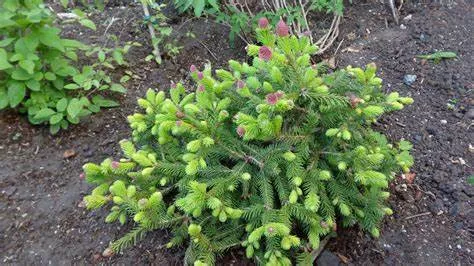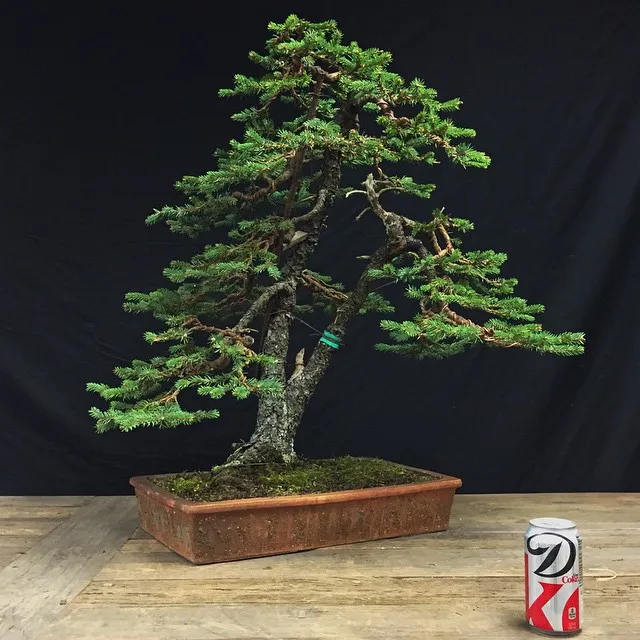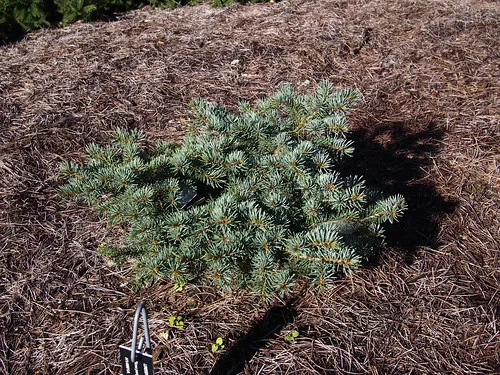How Do You Get Rid of Pest And Diseases On Dwarf Alberta Spruce?
Written by Ivy
Dec 11 2021

Dwarf Alberta spruce has strong cold resistance and plays an important role in landscaping and afforestation. However, the incidence of diseases and pests in dwarf Alberta spruce is relatively high, and the species are diverse. In the actual control process, we should pay attention to the pertinence of the control methods of dwarf Alberta spruce to enhance the control effect of diseases and pests as much as possible. Let's take a look at some common diseases and pests of Dwarf Alberta Spruce.
 Monochamus alternatus Hope larvae eat xylem and adults bite leaves, resulting in plant death. This dwarf Alberta spruce pest will also cause nematode wilt and a large number of plant death.
Monochamus alternatus Hope larvae eat xylem and adults bite leaves, resulting in plant death. This dwarf Alberta spruce pest will also cause nematode wilt and a large number of plant death.
② When the larvae hatch, spray 25% Guoke No. 3 200 times solution or 40% Omethoate 1000 times solution to control this Dwarf alberta spruce pest.
③ After the larvae moth into the branches, zinc phosphide poisonous cuttings are inserted into the holes to kill the larvae.
② After finding the diseased part of dwarf Alberta spruce, different treatment shall be carried out according to different conditions. For those with local cortical decay, use a knife to completely scrape away the disease spots. The scraped disease skin should be treated intensively and should not be thrown casually; You can also burn the disease department with a blowtorch to completely kill germs. If the whole root of dwarf Alberta spruce decays, it shall be sawn off from the base and pursued downward until the diseased root is dug up. Most of the root systems have been diseased, we should completely remove the diseased roots, and pay attention to protect the diseased roots from easy damage. After cleaning up the diseased area of dwarf Alberta spruce, we should apply bactericide on the wound to prevent recurrence; For larger wounds, paste mud or wrap plastic cloth for protection; For the seriously ill dwarf Alberta spruce, we need to inject medicine for sterilization or replace it with a new disease-free soil. The medicament used is 100 ~ 150 times of 50% ammonium substituted water agent. In addition, 40% arsenic forme wettable powder 500 ~ 800 times liquid, 2-degree stone sulfur mixture, 40% pentachloronitrobenzene powder 50 ~ 100 times toxic soil can also be used. For the soil around the diseased plant, 70% pentachloronitrobenzene powder, 0.2kg per plant, was prepared into 1:50 ~ 100 drug soil, which was evenly spread in the soil around the diseased plant. Or irrigate the root with 70% methyltobuzin or 50% carbendazim 500 times solution. Dig the seriously ill trees as soon as possible, collect the diseased roots and burn them.
③ For light diseased trees, as long as the affected parts are completely scraped and coated with medicine for protection, they can be recovered without special management.
② Protection against natural enemies such as walking insects, parasitic wasps and woodpeckers.
③ Chemical control. From the end of May to the beginning of July, adults fly into the peak period of invasion, and spray the branches and stems of living trees with 200 times of 2.5% dipterex ointment or 500 times of 30% cypermethrin ointment to control adults.
Read Next:
1. Monochamus alternatus Hope2. D·argentata Buller3. Root rot4. Leaf blight5. Red blight6. Hejieodasidium mompa Tanaka7. Ips typographus Linnaeus
1. Monochamus alternatus Hope

- Prevention methods:
② When the larvae hatch, spray 25% Guoke No. 3 200 times solution or 40% Omethoate 1000 times solution to control this Dwarf alberta spruce pest.
③ After the larvae moth into the branches, zinc phosphide poisonous cuttings are inserted into the holes to kill the larvae.
2. D·argentata Buller
Larvae eat leaves and feed from the middle of the leaves, causing the leaves to break. In serious cases, they eat all the leaves.- Prevention methods:
3. Root rot
The plant has no spirit. The needles turn yellow or suddenly turn blue-green, and the needles grow longer. Soon, the needles are soft and pour around in gray black. A small amount of common color appears at the base of some leaf bundles, and then they begin to take off the needles and fall leaves.- Prevention methods:
4. Leaf blight
At the beginning of the plant, colored yellow spots occur at the tip and middle of the leaves. Later, the color of the yellow spots turns dark, and many black mildew spots grow on the dark brown spots. This dwarf Alberta spruce disease is easy to occur in rainy and wet weather when the temperature is about 25C.- Prevention methods:

5. Red blight
The onset of this dwarf Alberta spruce disease will cause macular in local needles, which changes from light to dark and expands continuously, and finally dies.- Prevention methods:
6. Hejieodasidium mompa Tanaka
Hejieodasidium mompa Tanaka mainly endangers the root, presents purple black feathers, and finally the plant withers and dies. If the above diseases are not prevented and controlled as soon as possible, they will be devastating.- Prevention methods:
② After finding the diseased part of dwarf Alberta spruce, different treatment shall be carried out according to different conditions. For those with local cortical decay, use a knife to completely scrape away the disease spots. The scraped disease skin should be treated intensively and should not be thrown casually; You can also burn the disease department with a blowtorch to completely kill germs. If the whole root of dwarf Alberta spruce decays, it shall be sawn off from the base and pursued downward until the diseased root is dug up. Most of the root systems have been diseased, we should completely remove the diseased roots, and pay attention to protect the diseased roots from easy damage. After cleaning up the diseased area of dwarf Alberta spruce, we should apply bactericide on the wound to prevent recurrence; For larger wounds, paste mud or wrap plastic cloth for protection; For the seriously ill dwarf Alberta spruce, we need to inject medicine for sterilization or replace it with a new disease-free soil. The medicament used is 100 ~ 150 times of 50% ammonium substituted water agent. In addition, 40% arsenic forme wettable powder 500 ~ 800 times liquid, 2-degree stone sulfur mixture, 40% pentachloronitrobenzene powder 50 ~ 100 times toxic soil can also be used. For the soil around the diseased plant, 70% pentachloronitrobenzene powder, 0.2kg per plant, was prepared into 1:50 ~ 100 drug soil, which was evenly spread in the soil around the diseased plant. Or irrigate the root with 70% methyltobuzin or 50% carbendazim 500 times solution. Dig the seriously ill trees as soon as possible, collect the diseased roots and burn them.
③ For light diseased trees, as long as the affected parts are completely scraped and coated with medicine for protection, they can be recovered without special management.
7. Ips typographus Linnaeus
IPS typographus Linnaeus builds pits between the phloem and sapwood of pine trees. The tunnels are double longitudinal pits, which can also directly damage healthy trees. They often occur together with other IPS typographus Linnaeus, resulting in the withering of trees.- Prevention methods:
② Protection against natural enemies such as walking insects, parasitic wasps and woodpeckers.
③ Chemical control. From the end of May to the beginning of July, adults fly into the peak period of invasion, and spray the branches and stems of living trees with 200 times of 2.5% dipterex ointment or 500 times of 30% cypermethrin ointment to control adults.
Read Next:
- What Is The Best fertilizer For Dwarf Alberta Spruce
- How Deep Are Dwarf Alberta Spruce Roots?
- How To Grow Dwarf Alberta Spruce In Pots?
- Why Is My Dwarf Alberta Spruce Turning Brown?
- How Big Does a Dwarf Alberta Spruce Conica Get?
- What Is My Dwarf Alberta Spruce Growth Rate
- How To Trim Dwarf Alberta Spruce
- Dwarf Alberta Spruce (Picea Glauca Conica) Profile
Latest Updated
- Dwarf Alberta Spruce Overwatering: Causes And Solutions
- How Do You Get Rid of Pest And Diseases On Dwarf Alberta Spruce?
- How Much & How Often to Water String of Turtles Plant?
- String of Turtles Plant (Peperomia Prostrata) Care & Propagation Guide
- String of Pearls Plant Care & Propagation
- How To Trim Dwarf Alberta Spruce
- What Is My Dwarf Alberta Spruce Growth Rate
- How Big Does a Dwarf Alberta Spruce Conica Get?
- Why Is My Dwarf Alberta Spruce Turning Brown?
- How To Grow Dwarf Alberta Spruce In Pots?
Popular Articles
- How to Grow Terminalia Mantaly Tree
- How to Grow and Care for Crossostephium Chinense
- Peristeria Elata (Dove Orchid) Profile: Info & Care Guide
- Graptopetalum Purple Delight: How to Grow & Care for Graptopetalum Purple Delight in summer
- Rhododendron Simsii Plant Care & Growing Guide
- Rosa Chinensis (China Rose) Grow & Care Tips
- Sinningia Leucotricha Profile
- How to grow and care for Euonymus japonicus
- Echeveria Mebina Profile
- How to Propagate Goldfish Plant